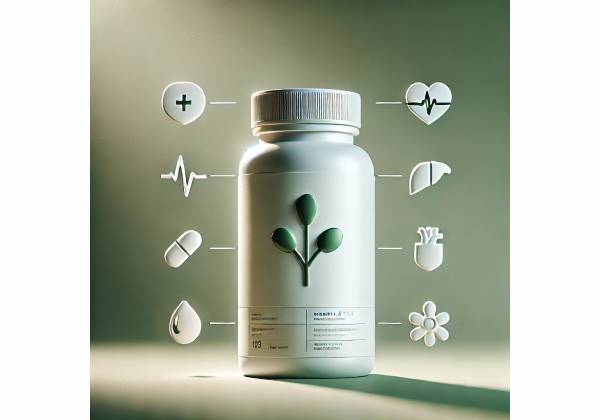
Mistletoe refers to several semiparasitic plants, most notably European mistletoe (Viscum album). Extracts from Viscum album have been used for a century in parts of Europe, especially in integrative oncology, where physician-prescribed injections aim to support quality of life during cancer care. Beyond oncology, mistletoe appears in traditional cardiometabolic and nervous-system remedies, though modern evidence is uneven. The plant contains bioactive lectins, viscotoxins, and polysaccharides that can modulate immune signaling and provoke a mild fever response. This is not the decorative American mistletoe used at holidays; ingestion of mistletoe leaves or berries can be dangerous, and medical-use extracts differ markedly by how they are grown, harvested, and prepared. In the United States, prescription mistletoe injections are not approved as a drug, and oral supplements have limited data. Used appropriately, the best-supported role is as an adjunct to standard cancer treatment to improve symptom burden and day-to-day well-being, with safety guardrails and clinician oversight. This guide explains what mistletoe is, what the science does and does not show, how it is used in practice, and when to avoid it.
Quick Overview
- Adjunct use in cancer care can improve quality of life and fatigue in some studies.
- Berries and leaves are toxic if ingested; physician-supervised products only.
- Typical regimen in studies: subcutaneous injections 2–3 times per week (clinician directed).
- Avoid in pregnancy, during breastfeeding, or with uncontrolled autoimmune or allergic disorders without specialist input.
Table of Contents
- What is mistletoe extract?
- Does mistletoe work for cancer support?
- Benefits and mechanisms: what to expect
- How to use mistletoe safely
- How much mistletoe should I take?
- Side effects, interactions, and who should avoid
What is mistletoe extract?
Mistletoe is a umbrella term for semiparasitic plants that grow on host trees. The species most discussed in medicine is European mistletoe (Viscum album). It draws water and minerals from a host tree but performs its own photosynthesis. The composition of the plant varies with the host species (apple, oak, pine, spruce, and others), season of harvest, and manufacturing process (fermented versus unfermented; aqueous versus hydroalcoholic extraction). These factors influence levels of lectins (sugar-binding proteins), viscotoxins (small cytotoxic proteins), and polysaccharides, which together shape immune and cellular effects observed in laboratory and clinical contexts.
Medical-use preparations. In Europe, several standardized Viscum album extracts are marketed as prescription injectable products used by trained clinicians, usually administered subcutaneously (under the skin) multiple times per week. Brand families may reference the tree host (for example, “M” for apple, “P” for pine). While there is debate about matching host-tree–derived extracts to tumor types, the practical point for patients is that these are regulated, physician-directed therapies, not over-the-counter teas or tinctures.
Regulatory status. In the United States, mistletoe injections are not approved as a drug. Some clinics offer them under research protocols or within integrative practices, but availability and oversight differ by jurisdiction. Oral supplements (capsules, liquid extracts, teas) may be sold as dietary supplements; these are not equivalent to prescription injections, and safety and effectiveness data are limited. Self-harvesting or ingesting plant parts is unsafe; mistletoe berries and leaves can cause serious toxicity.
How it is thought to work. Mistletoe constituents can trigger local and systemic immune responses. Lectins bind to cell-surface sugars and may induce cytokine release; viscotoxins can disrupt cell membranes; polysaccharides can modulate innate immunity. Injections often cause a predictable local inflammatory reaction (redness, warmth) and sometimes a low-grade fever, which some protocols use to guide dose titration. These effects are adjunctive—they do not replace chemotherapy, radiation, targeted drugs, or surgery. The most responsible use is within a comprehensive care plan overseen by an oncology team.
Terminology clarity. “Mistletoe therapy” in clinical discussions nearly always means injectable Viscum album extracts. “American mistletoe” (Phoradendron spp.) is a different plant, commonly decorative, and should not be used medicinally. When reading product labels, check that the species is Viscum album, that the use is clinician-directed, and that the product has robust quality controls (batch testing, sterility, endotoxin limits, documented active constituents).
In short, mistletoe as a supplement is not a single, simple herb. It is a family of preparations, with the strongest medical use case being clinician-prescribed injectable extracts designed to support quality of life during cancer care, with careful attention to dosing, reactions, and safety.
Does mistletoe work for cancer support?
The most consistent signal in modern research is quality-of-life (QoL) improvement for some patients receiving mistletoe alongside standard cancer therapy. Multiple randomized and nonrandomized studies—spanning breast, colorectal, lung, pancreatic, and other cancers—report medium-sized improvements in patient-reported outcomes such as fatigue, sleep, appetite, pain, or global health status. Meta-analyses focused on QoL have concluded that, despite study heterogeneity and challenges with blinding (injections can cause noticeable local reactions), the overall effect is clinically meaningful for some populations. A separate meta-analysis centered on cancer-related fatigue found a moderate benefit comparable in magnitude to structured physical-activity programs. These outcomes speak to day-to-day functioning, not tumor shrinkage.
When it comes to survival or tumor control, the picture is less clear. Historical pooled analyses and contemporary reviews include positive findings, neutral results, and studies at risk of bias (e.g., unblinded designs, selection bias, inadequate control of co-interventions). Large, high-quality randomized trials with standardized dosing and pre-registered outcomes are limited. Consequently, authoritative summaries emphasize that mistletoe should not be used as a standalone anticancer treatment and that better trials are needed to define who benefits, optimal regimens, and interactions with modern oncology (e.g., checkpoint inhibitors, targeted therapies).
What practical benefits are reasonable to expect? For patients experiencing chemotherapy-related symptoms—notably fatigue, reduced appetite, sleep disturbance, and general malaise—mistletoe may help reduce symptom burden and support treatment tolerance. Some clinicians use it with goals such as improving energy or stabilizing weight when appetite is poor. Reported improvements usually emerge over several weeks, aligning with the cumulative nature of immune-modulating therapies.
What does not align with evidence? Claims that mistletoe cures cancer or replaces medical therapy are not supported. The research base does not yield a single, uniform survival advantage across cancers. Where signals exist, they are context-dependent and should be interpreted cautiously.
Why is the evidence mixed? Three reasons dominate:
- Product variability. Extracts differ by host tree, fermentation, and standardization, making trials hard to compare.
- Dosing heterogeneity. Regimens vary (starting dose, escalation rules, pauses for fever), often individualized.
- Methodological constraints. Blinding is difficult; some studies lack rigorous randomization or endpoint adjudication.
Bottom line. For patients who value quality-of-life support during conventional cancer care, mistletoe—when prescribed and monitored by experienced clinicians—can be reasonable to consider. Expectations should be grounded: benefits are more likely to be symptom-focused rather than disease-controlling, and decisions should be made in partnership with the oncology team to ensure compatibility with the overall treatment plan.
Benefits and mechanisms: what to expect
Quality of life and fatigue. The most robust clinical outcomes relate to global QoL and cancer-related fatigue. Pooled analyses describe medium effect sizes, indicating differences patients can feel—more energy, improved functioning, or better overall well-being—especially during chemotherapy or early survivorship. Not every individual improves, and placebo effects and expectation can influence self-reported measures. Yet, when data are aggregated across dozens of trials, the signal persists.
Immune modulation. Mechanistically, mistletoe lectins can bind to glycoproteins on immune cells, prompting cytokine release and activation of natural killer cells in preclinical models. Clinically, subcutaneous injections often produce local erythema (a red, warm area around the injection site) and sometimes a transient fever—interpreted as signs of immune engagement. Some protocols titrate the dose to achieve a predictable, mild reaction (for example, a local reddened area of several centimeters and a temperature <38.5 °C), then hold or step back if reactions exceed targets. This symptom-guided titration helps individualize exposure while limiting adverse effects.
Possible symptom domains. Patient-reported benefits in studies most commonly include:
- Reduced fatigue and improved work or role functioning.
- Appetite stabilization and less nausea.
- Better sleep and emotional well-being.
- In some cohorts, fewer infections or shorter sick-leave durations, though these findings are inconsistent and require cautious interpretation.
Where evidence is weak or inconsistent. Claims about blood pressure, glucose control, or broad anti-inflammatory benefits outside oncology often trace back to older, lower-quality studies or traditional use. Such uses should not be generalized to modern practice without updated, well-designed trials. Similarly, any implication that mistletoe can prevent cancer or reduce recurrence is not supported by high-certainty evidence.
Sustainability and standardization. Modern manufacturers cultivate mistletoe under controlled conditions and standardize extracts to reduce batch variability. Even so, differences remain across brands (fermentation, host tree, defined bioactive ranges). This heterogeneity underscores why clinicians typically use brand-specific protocols and monitor patient reactions rather than relying on a one-size-fits-all dose table.
A realistic benefits profile. The most defensible clinical value of mistletoe today is adjunctive symptom relief and quality-of-life support in cancer care, achieved through immunomodulation that is felt by patients as improved energy or resilience. It should be integrated with, not instead of, evidence-based oncologic treatments and supportive care measures (nutrition, exercise, sleep, psychosocial support).
How to use mistletoe safely
1) Work with the right clinician. If you are considering mistletoe, involve your oncologist and an experienced integrative physician. They can evaluate suitability, coordinate timing with chemotherapy, immunotherapy, or radiation, and select a protocol aligned with your diagnosis and goals. This coordination reduces the risk of unintended interactions and ensures adverse events are addressed promptly.
2) Use appropriate products only. For oncology support, that means sterile, injectable Viscum album extracts from reputable manufacturers with lot-specific testing (sterility, endotoxin limits, identity/potency). Avoid nonstandard sources, compounded products without documented quality, or any preparation not intended for subcutaneous use. Oral teas, tinctures, or capsules do not substitute for physician-prescribed injections and lack comparable evidence; ingesting plant parts (berries or leaves) is unsafe.
3) Understand typical administration. In clinical practice and studies, mistletoe is commonly given 2–3 times per week subcutaneously, often in the upper abdomen or thigh, with rotation of injection sites. Doses are titrated based on local skin reaction and systemic symptoms (e.g., fever, malaise). A small, warm, slightly tender area around the injection site is expected; protocols often target a modest reaction rather than none at all. If reactions become excessive—large, painful swelling; fever ≥38.5 °C; generalized rash—clinicians pause or reduce the dose.
4) Plan around your treatment calendar. Teams frequently avoid injections on infusion days or within 24 hours of chemotherapy to minimize confounding. Around surgery, some clinicians stop injections 1–2 weeks before and resume after adequate wound healing; policies vary by center. With immunotherapy, practices differ: some centers avoid starting mistletoe until immune-related adverse event risk is clarified; others use it cautiously within protocols. Coordination is essential.
5) Expect and track responses. Keep a simple diary of injection date, site, local reaction size, temperature, and symptoms. This helps your clinician fine-tune dosing. If you experience hives, wheezing, dizziness, or fever above your clinician’s threshold, contact the team and hold further injections until you are advised.
6) Storage and handling. Store vials as directed (often refrigerated), protect from light, and discard after the labeled in-use period. Use aseptic technique for injections if self-administering under instruction. Do not share vials or syringes; follow local regulations for sharps disposal.
7) Do not self-harvest or self-experiment. Home-prepared teas or tinctures from wild mistletoe can be toxic and unpredictable in potency. Children and pets are especially vulnerable to poisoning. Stick to clinician-prescribed regimens and regulated products.
8) Keep perspective. Mistletoe is best thought of as one piece of a supportive-care bundle: nutrition, exercise, sleep, symptom-directed medications, and psychosocial supports all contribute to how you feel during treatment. Discuss where mistletoe fits and what outcomes matter most to you (energy, appetite, sleep, fewer interruptions to therapy).
Used in this deliberate, team-based way, mistletoe can support comfort and functioning while keeping risks contained. The safety net is clinical supervision and clear stop rules for overreactions.
How much mistletoe should I take?
There is no universal “dose” for mistletoe. Regimens are individualized and brand-specific. In the context of integrative oncology, physicians typically prescribe subcutaneous injections 2–3 times per week, with dose escalation guided by clinical response rather than a fixed mg-per-kg table. The aim is to reach a stable, modest local reaction (for example, a warm, reddened area at the injection site that is noticeable but not disabling) and avoid high fevers or systemic reactions.
A practical way clinicians structure dosing:
- Initiation. Start at a low strength specific to the brand used. First injections may occur in clinic to observe reactions and review technique.
- Titration. Increase stepwise over days to weeks, watching for local erythema and general symptoms. If the reaction is too small, a slightly higher strength is used; if excessive (e.g., large painful swelling, fever ≥38.5 °C), the dose is reduced or held until symptoms settle.
- Maintenance. Once a steady state is reached, continue at that strength, usually 2–3 times weekly. Some protocols introduce treatment breaks (for example, weekends off) or cycles (several weeks on, then a pause).
- Duration. Treatment length varies widely—from a few months during chemotherapy to longer courses in survivorship for symptom management—based on goals and tolerance.
- Special situations. Around surgery or during high-risk periods for infection or immune-related adverse events, clinicians may pause dosing. Coordination with the oncology team is standard.
What about oral mistletoe? There is no established, evidence-based oral dose that reproduces the effects seen with injections. Most clinical research has evaluated injectable extracts. Because berries and leaves are toxic, and tinctures vary in composition, do not self-dose oral products for cancer-related goals. If you encounter a product claiming safe oral dosing for serious disease, treat it with skepticism and consult a qualified professional.
Self-directed dosing is not appropriate. Unlike common nutraceuticals with clear label doses (e.g., vitamin D in IU), mistletoe’s biologic effects and target reactions require clinical monitoring. If you cannot access an experienced prescriber and a product with verifiable quality controls, it’s safer to defer mistletoe than to experiment on your own.
Setting expectations. If mistletoe is appropriate for you, your clinician will write a patient-specific plan: the brand and series, starting strength, escalation rules, pause thresholds, and how to time injections around chemotherapy or immunotherapy. The most important “dose” details, therefore, are frequency (2–3 injections/week) and titration to a modest reaction, not a one-size-fits-all mg number.
Side effects, interactions, and who should avoid
Common, expected reactions (usually mild and manageable):
- Local injection-site reaction: redness, warmth, mild swelling, tenderness. Protocols often target a small reaction.
- Transient systemic symptoms: low-grade fever, chills, headache, or fatigue within 24–48 hours of injection. These effects typically lessen with dose adjustments.
- Flu-like feelings: aching or malaise on titration days; usually responsive to dose reduction or spacing injections.
Less common but important:
- Allergic reactions: generalized rash, hives, wheezing, or hypotension are rare but require immediate medical care and discontinuation.
- High fever: temperatures ≥38.5 °C or persistent fevers merit a dose hold and clinician review.
- Excessive local inflammation: large, painful, or suppurative reactions are indications to pause or change the site/strength.
- Liver enzyme elevations: infrequent signals exist; clinicians may monitor ALT/AST if clinically indicated.
Toxicity warnings unrelated to medical extracts: Do not ingest mistletoe berries or leaves. Poisonings have occurred from teas and home preparations. Keep plant material away from children and pets.
Interactions and timing considerations:
- Chemotherapy and targeted therapies: Many centers schedule injections on non-infusion days; individualize based on regimen and symptom goals.
- Immunotherapy (e.g., PD-1/PD-L1, CTLA-4 inhibitors): Because mistletoe can modulate immune activity, start only with oncologist approval. Some teams defer initiation until the risk window for immune-related adverse events becomes clearer.
- Surgery: Discuss timing with your surgeons and oncologists. Some clinicians hold injections 1–2 weeks before major procedures, resuming after wound stability.
- Antipyretics: Routine prophylactic use (e.g., acetaminophen before each injection) may mask dose-guiding signs; only use under clinician guidance.
- Pregnancy and breastfeeding: Avoid mistletoe; safety data are insufficient, and plant parts are potentially toxic.
- Autoimmune disease and severe allergy history: Use caution and specialist input; titration thresholds may be lower or the therapy may be inappropriate.
Who should avoid or seek specialist advice first:
- Individuals who are pregnant or breastfeeding.
- Anyone with a history of severe allergic reactions to botanical injectables or known mistletoe components.
- Patients with uncontrolled autoimmune disorders unless a specialist deems it appropriate.
- People considering oral mistletoe for serious disease. This approach lacks supportive evidence and carries toxicity risk.
Practical safety habits:
- Use clinician-prescribed products with lot-specific sterility and potency data.
- Keep a reaction log (site, size, symptoms, temperature).
- Know your pause rules (e.g., reaction size beyond the plan, fever thresholds).
- Integrate mistletoe into a shared decision-making process with your oncology team.
With these boundaries, the likelihood of serious harm is low, and the therapy can be tailored to comfort and function goals during cancer care.
References
- Mistletoe Extracts (PDQ®)–Health Professional Version 2024 (Guideline)
- European Mistletoe 2024 (Guideline)
- Quality of life in cancer patients treated with mistletoe: a systematic review and meta-analysis 2020 (Systematic Review)
- Cancer-related fatigue in patients treated with mistletoe extracts: a systematic review and meta-analysis 2022 (Systematic Review)
- Mistletoe extracts for cancer treatment 2022 (Systematic Review/Protocol)
Disclaimer
This information is educational and not a substitute for personalized medical advice, diagnosis, or treatment. Do not start, stop, or change any therapy—including mistletoe—without guidance from your oncology and primary care teams. Injectable mistletoe should be prescribed and monitored by experienced clinicians. If you are pregnant, breastfeeding, considering surgery, or have significant allergies or autoimmune disease, seek specialist advice before use.
If this article helped you, please consider sharing it on Facebook, X (formerly Twitter), or your preferred platform, and follow us for updates. Your support helps us continue creating clear, evidence-informed resources.










